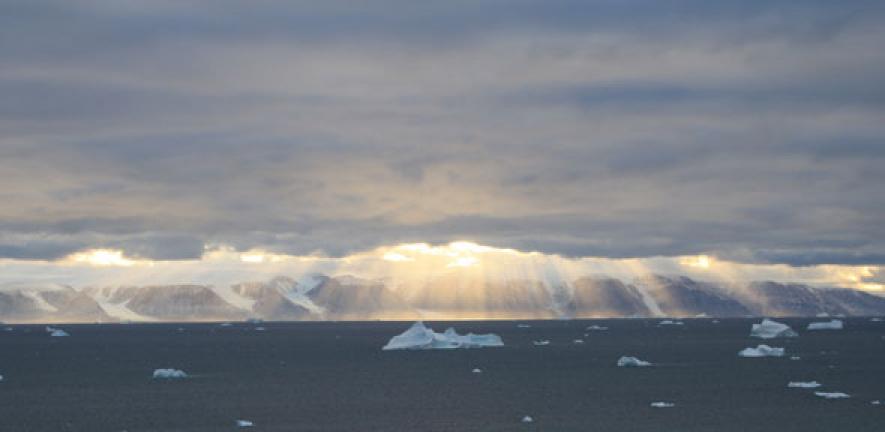
Economic modelling shows that the possible methane emissions caused by shrinking sea ice from just one area of the Arctic could come with a global price tag of 60 trillion dollars - the size of the world economy in 2012.
Economic modelling shows that the possible methane emissions caused by shrinking sea ice from just one area of the Arctic could come with a global price tag of 60 trillion dollars - the size of the world economy in 2012.
This is a warning to the world borne out of many decades of research.
Peter Wadhams
As the Arctic warms and sea ice melts at an unprecedented rate, hitting a record low last summer, the thawing of offshore ‘permafrost’ - frozen soil - in the region is releasing methane, a powerful greenhouse gas.
Scientists have previously warned that there are vast reservoirs of methane in the Arctic, hundreds of billions of tonnes of a gas many times worse than carbon dioxide for global warming - of which only a fraction needs releasing into the atmosphere to trigger possibly catastrophic climate change.
Now, researchers from Cambridge and Rotterdam have for the first time calculated the potential economic impact of a scenario some scientists consider increasingly likely: that the methane below the East Siberian Sea will be emitted, either steadily over the next 30 years or in one giant “burp”.
Writing in the journal Nature, the academics say that just this area’s methane alone - some 50 billion tonnes, or 50 gigatonnes - would have a mean global impact of 60 trillion dollars, an amount very similar to the size of the entire global economy last year. Current US national debt stands at a mere 16 trillion dollars in comparison.
The economic impact modelled was only for the methane existing on the East Siberian Arctic Shelf, and “the total price of Arctic change will be much higher,” they warn.
“Arctic science is a strategic asset for human economies because the region drives critical effects in our biophysical, political and economic systems,” write the academics, who say that world leaders will “miss the bigger picture” without factoring in Arctic methane projections - as neither the World Economic Forum or the International Monetary Fund currently recognise the economic danger of Arctic change.
The new results were achieved using PAGE09, the latest version of the PAGE integrated assessment model developed by Dr Chris Hope from Cambridge Judge Business School. PAGE09 is currently used by the US Environmental Protection Agency, and an earlier version was used for the UK Government’s Stern Review in 2006 - the major report on climate change economics on which Hope was a specialist advisor.
For the latest research, Hope worked with Gail Whiteman, Professor of Sustainability at Erasmus University, and Cambridge’s Peter Wadhams, Professor of Ocean Physics, who has been studying the disappearance of Arctic ice for 40 years.
The three academics, who co-authored today’s Nature Comment article, built the projections on previous fieldwork in the region by Dr Natalia Shakhova and colleagues from the International Arctic Research Center at the University of Alaska, described by Wadhams as “the only people with the geological knowledge to make estimates about methane emission in this area”.
The PAGE09 model was then employed to translate the extra methane emissions from the East Siberian Sea into global impacts by considering the huge range of environmental changes they might cause - from increasing global temperature and sea levels to consequent flooding, public health and extreme weather.
The model was run 10,000 times to assess the range of risks and provide robust results. The team insist that both the scientific predictions and economic modelling are far from worst-case scenarios, and that the figures represent the mean result from “the whole range of available science and economics”.
“That’s how the model works, how it was used for Stern and by the EPA, it’s the only way I’ll allow it to be used,” said Hope. “The model has to be run with broad ranges for the inputs, it’s not justifiable otherwise.”
“This is the first calculation of its kind that we know of,” he adds, “and we welcome anyone who wants to take this forward and build on it so we can have a discussion - but we don’t have long to discuss it! This is so big and if it happens it could happen fast; people need to wake up to the possible reality we face”.
"This is a warning to the world borne out of many decades of research on all our parts, including forty years of ice thinning measurements from UK submarines,” said Wadhams, “it is a considered statement with enormous implications".
The research also explored the impact of a number of later, longer-lasting or smaller pulses of methane, and the authors write that, in all these cases, the economic cost for physical changes to the Arctic is “steep”, with developing nations bearing 80% of the cost through extreme weather, poorer health and damaged agriculture.
The authors write that global economic institutions and world leaders should “kick-start investment in rigorous economic modelling” and consider the changing Arctic landscape as an “economic time-bomb” far outweighing any “short-term gains from shipping and extraction”.
This work is licensed under a Creative Commons Licence. If you use this content on your site please link back to this page.





